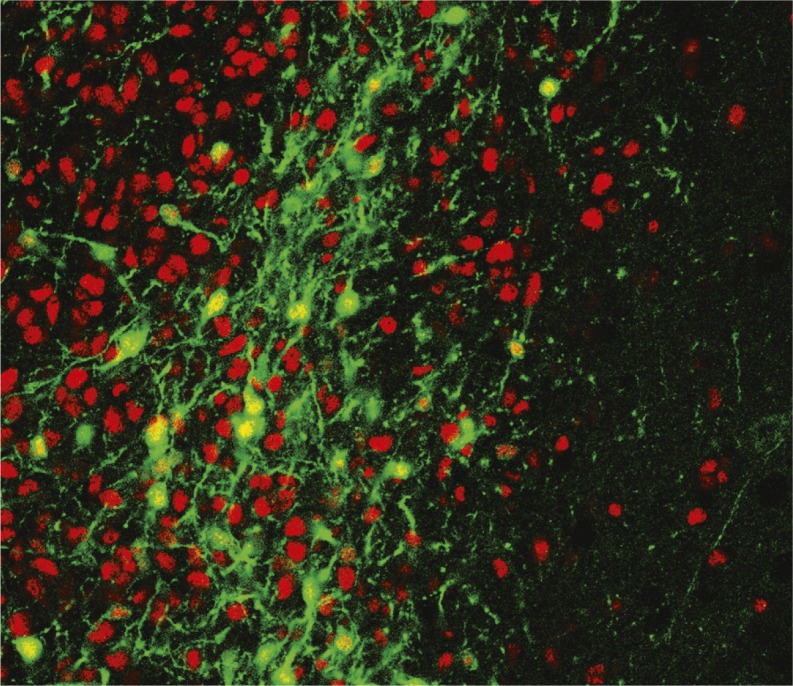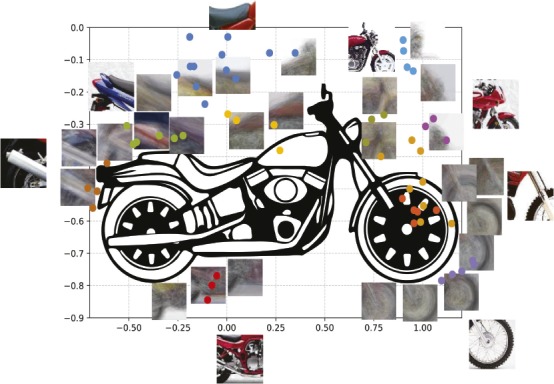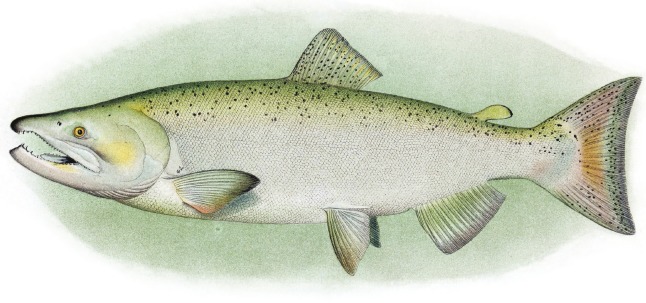Anthropogenic impacts on Chinook salmon
Illustration of Chinook salmon. Image courtesy of Wikimedia Commons/A. Hoen and Co.
Phenotypic variation enables species to evolve when faced with environmental changes, including climate change. However, human activity, such as dam construction, endangers phenotypic diversity, with homogeneous species being particularly vulnerable. Tasha Thompson, Michael Miller, et al. (pp. 177–186) examined changes in the migration characteristics of wild Chinook salmon, particularly whether the salmon were spring-run or fall-run, across the southern portion of their coastal North American range. Using DNA analysis, the authors examined 269 individual Chinook salmon from the Rogue River that passed a fish counting station during three approximately 1-week-long intervals in May, August, and October 2004. The sharp decrease in spring-run Chinook and corresponding increase in fall-run Chinook that occurred after the construction of a dam in 1977 were explained by changes in allele frequencies at the GREB1L gene locus, which is associated with migration. Further, the authors suggest, continued suppression of the previously abundant spring-run phenotype could lead to loss of the spring-run allele, given that Chinook populations that have experienced longer-term suppression and loss of spring-run Chinook in northern California’s Shasta and Scott Rivers proved to be unsustainable genetic reservoirs of the allele. Thus, loss of the spring-run allele could prevent Chinook salmon populations from recovering previous phenotypic diversity and adapting to challenges, such as climate change, highlighting the need to conserve and restore phenotypic variation, according to the authors. — T.G.
Effects of sugar on beneficial gut bacteria
As understanding of the role of the gut microbiota in human health expands, researchers have found that diet influences gut microbiomes by providing nutrients to particular species assemblages. Among the species associated with lean and healthy individuals is Bacteroides thetaiotaomicron. Guy Townsend II et al. (pp. 233–238) investigated the effect of a high-fructose diet on B. thetaiotaomicron populations, given that fructose, as well as the monosaccharide glucose, is abundant in the Western diet. The authors found that the bacteria require a protein called Roc for gut colonization, and that both fructose and glucose decreased the abundance of the Roc protein within 1 hour in bacterial cultures. The authors engineered a strain of B. thetaiotaomicron resistant to Roc silencing by glucose and fructose, and demonstrated that the strain outcompeted the wild-type strain in mice fed a diet high in glucose and sucrose, a disaccharide composed of glucose and fructose. According to the authors, the results suggest that diet can regulate bacterial colonization in the gut, and that the role of diet in the gut microbiota goes farther than merely providing nutrients. — P.G.
Cell grafts for epilepsy treatment

Differentiation of human iPSC-MGE cells (red) into interneurons (green) in epileptic hippocampus.
Status epilepticus (SE), a prolonged period of seizures without recovery, can lead to chronic epilepsy. Grafting of medial ganglionic eminence (MGE) cells into the hippocampus following SE has been explored as a potential treatment for chronic epilepsy, but the long-term efficacy and clinical potential of such grafts have not been established. Dinesh Upadhya et al. (pp. 287–296) generated human MGE-like cells from human induced pluripotent stem cells (hiPSC) and transplanted the cells into the hippocampus of rats following SE induction. In the chronic epileptic phase after SE, over a 3-week period, rats that received MGE grafts had a lower frequency of spontaneous recurrent seizures and spent less time in seizure activity than rats that did not receive grafts. MGE grafts also alleviated SE-induced cognitive and mood dysfunctions observed in control rats. Rats with grafts exhibited reductions in abnormal neurogenesis, interneuron loss, and aberrant mossy fiber sprouting, compared with control rats. Pharmacologic inactivation of graft-derived interneurons led to an increase in seizure activity. The results support the therapeutic efficacy of hiPSC-derived MGE cells for alleviating chronic epilepsy and raise the possibility of autologous MGE grafts. Autologous grafts could preclude the need for immune suppression after grafting and promote long-term graft–host integration, according to the authors. — B.D.
Brain-inspired computer vision

Colored dots show estimated coordinates of centers of some viewlets in the motorbike SUVM. Each viewlet is a composite of views/patches with similar appearances. Image courtesy of Lichao Chen, Tianyi Wang, and Vwani Roychowdhury (University of California, Los Angeles).
Most existing object recognition programs rely on supervised training of algorithms using bounding boxes or object labeling of hundreds of images. However, the human brain learns to recognize objects in varied contexts without repeated training. Inspired by the brain’s unsupervised learning ability, Lichao Chen et al. (pp. 96–105) incorporated basic computational principles that the brain likely uses to perform visual recognition and developed Structural Unsupervised Viewlets Models (SUVMs) of humans, cars, and airplanes, among other targets. The authors developed a series of viewlets, which are images depicting pieces of objects, such as an arm, in different poses or orientations, together with a spatial map of how the pieces mesh together to create an entire object. The authors tested the SUVMs on two existing visual datasets. The face and human SUVMs recognized human faces correctly without false positives. The airplane SUVM performed less well, a result that the authors attribute to the relatively small number of training images presented. Adding relative probability to viewlets could increase the sensitivity of the models, which could be potentially applied to videos, according to the authors. — T.H.D.



